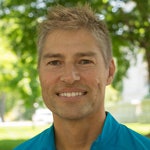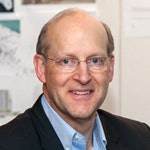![St. Louis University, 1982 Facility of Merit Recreation Center [Photo courtesy of Hastings+Chivetta]](https://img.athleticbusiness.com/files/base/abmedia/all/image/2017/05/ab.campus417_feat.png?auto=format%2Ccompress&q=70&w=400)
Building a facility specifically for recreation was a novel concept when St. Louis University's campus recreation center was named an Athletic Business Facility of Merit® in 1982. In the 35 years since, the definition of "recreation" and its place in the college landscape has changed dramatically, as evidenced in AB's collective roster of Facilities of Merit.
"The St. Louis University Recreation Center was built for one purpose only — recreation … unstructured, play-when-you-want recreation." |
The Core Components
The campus recreation center has its roots in physical education facilities. Meant for instruction, these early buildings weren't an inviting place. "Almost all schools in the '60s and '70s offered health education buildings, and they were primarily for teaching young people to become phys ed teachers in elementary and high schools," says Erik Kocher, design principal with St. Louis-based Hastings+Chivetta Architects. "Each of those activity spaces was a windowless box because you were teaching."
The core spaces serving recreation — gymnasia, weight rooms, pools — have carried through to the dedicated recreation facility, and though the allocation of square footage has changed, few of those core spaces have disappeared from the blueprint, says Jack Patton of RDG Planning & Design in Des Moines, Iowa. "There are a variety of core spaces that remain core functions inside the recreation center. Gymnasia have evolved into something much more light-filled, higher-volume, more multipurpose."
"We designed a building that functions as something much greater and much more expansive than just a gym."— Bill Manning, department of rec director for the University of California-Berkeley Recreation Sports Center, a 1985 Facility of Merit |
"A gym is a gym, but how we treat the edges has evolved," agrees Colleen McKenna in CannonDesign's Boston office. "The gym and the core components are still there, but the edges are much more open and soft and fluid. Both vertically and horizontally, those edges are much more transparent and therefore much more interesting. The solidity of a gym with four walls and a door was driven by function in earlier buildings. All of those edges are treated completely differently, even if the court sizes are still the same. There's so much more vibrancy between spaces."
Perhaps the most noteworthy addition to the core program spaces was the MAC (multipurpose activity court), making its debut in the early 1990s. Capable of serving traditional activities such as basketball and volleyball, multipurpose courts also opened the doors to new activities, and not just sports. "Looking at the whole history of things, we see more and more interest in the MAC as a space that can be used for a lot of different things," says Reed Voorhees of CannonDesign in St. Louis. "They can be used for inline hockey, banquets, sleep-ins — all sorts of things. Those continue to evolve, but we see a lot of interest in those because they can be so heavily programmed."
Some of the core components have stuck around because of simple structural durability. "Take racquetball," Patton says, pointing to a sport that peaked in popularity in the early 1980s. "Racquetball over time has not been a core space, but it was built as a newly engaged activity, and unfortunately, the way they were built — hard, masonry walls, down in the bowels of the building — they just sort of stayed around. They have this 40-year legacy now only because they refuse to move."
![University of Toledo campus recreation center, a 1992 Facility of Merit [Photo Courtesy of Hastings+Chivetta]](https://img.athleticbusiness.com/files/base/abmedia/all/image/2017/05/ab.campus1.png?auto=format%2Ccompress&fit=max&q=70&w=400) University of Toledo campus recreation center, a 1992 Facility of Merit [Photo Courtesy of Hastings+Chivetta]
University of Toledo campus recreation center, a 1992 Facility of Merit [Photo Courtesy of Hastings+Chivetta]
A Social Revolution
Honored as a Facility of Merit in 1992, the campus recreation center at the University of Toledo was notable for breaking from the traditional 25-yard rectangular lap pool, heralding an age of lazy rivers, waterfalls and sunbathing shelves. "Aquatics has changed from a regimented, deep-water, lap-lane-oriented activity to an almost-anything-goes philosophy," says Patton, adding that the "push toward leisure water, shallow water, social recreation space is overlaid with a significant multipurpose consideration."
These pools, as well as many other components of the recreation center, haven't abandoned their initial purpose but have expanded to serve a more-diverse range of interests. "Swimming laps in a rectangular pool was and always will be a great thing to do, but sometimes the water depth limited other recreational activities," says Voorhees. "Creating opportunities for more leisure-type activities will draw more students in and create more social opportunities."
A college recreation center with a leisure pool, barbeque pit and cafeteria? |
This shift to include more leisure and social functions was part of a coming of age for campus recreation programs, says McKenna. "For so many years, recreation had to fight to get their own space," she explains. "As they got out from under the umbrella of athletics and we started seeing independent, freestanding recreation centers, their position and the importance of everything they do has solidified. They fought for so long just to get their own basic stuff that now that that baseline is established and with the success of these programs, they're able to take a broader vision and do more."
The modern campus recreation program recognizes that health is more than just physical wellness. Perhaps the best evidence of this shift comes from NIRSA, a now-obsolete acronym for the leading campus rec association. Originally the "National Intramural-Recreational Sports Association" the association has "evolved beyond these five words," according to its website.
"The first campus where I heard about stress-reduction and student respite as a motivation for an attractive and welcoming recreation facility was Johns Hopkins in the late '90s," says Chris Sgarzi, principal with Sasaki Associates in Watertown, Mass., "but now we hear this on many campuses, as awareness of the importance of student wellbeing continues to expand."
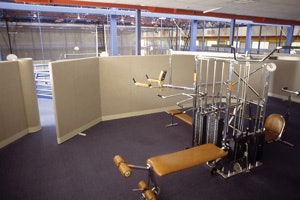 St. Louis University’s “state-of-the-art” weight room in 1982.
St. Louis University’s “state-of-the-art” weight room in 1982.
Fitness & Wellness
Fitness remains a core element of the campus recreation center, but the concept today is hardly recognizable from 40 years ago. "The fitness spaces have ballooned and changed over time," Patton says. "The layouts, the transparency of the spaces, the safety of that equipment, accessibility, has all impacted the design of spaces related to weights and fitness."
UCLA's Wooden Center, a 1985 Facility of Merit, boasted a 3,200-square-foot weight room — not nearly large enough to accommodate today's complex workouts. From the first weight rooms, fitness evolved into what many consider the Big Three — free weights, selectorized machines and cardio equipment — and today, many recognize a fourth dimension. "The biggest growth we're seeing is the need for functional training," says James Braam of HOK in Kansas City, Mo. "People want to be able to design their workout. Where we used to have smaller nooks for stretching, we're seeing a whole workout where you may be stretching as part of a core workout, then doing sprints back and forth on a piece of indoor turf — that space is there and dedicated but also needs to be flexible."
"If I could change one thing about the building, I would make the weight room even bigger."— University of California-Riverside’s recreation sports director Butch Mayo on the 1994 Facility of Merit |
Indoor turf, modular fitness rigs, inclined and twisting jogging tracks, sleds and tires are all now common elements of the fitness floor. The same complexity of design has also spread to the group exercise studio. "Thirty years ago, what might have been called a dance room has evolved into group fitness," Patton says. "Those spaces have moved from indoor to outdoor, from small and dark to bright and open, from poorly tuned finishes to highly tuned surfaces and materials, acoustics, and technological enhancements."
Additionally, as the mission of recreation shifts from physical fitness to include mental and emotional wellbeing, services complementary to exercise are finding their way into the recreation center. "There's this greater appreciation now for wellness in a holistic sense," Braam says. "We're seeing a change toward not only clinical, but also psychological services, as well as nutrition. We're only touching the surface right now. We're seeing greater opportunity to have a full health and wellness component within these buildings."
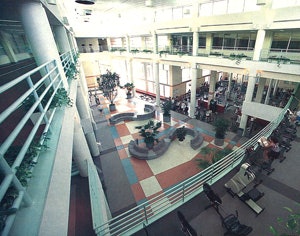 A view of the mezzanine level at Florida State University
A view of the mezzanine level at Florida State University
Generation-All
The demographics of today's recreation center have shifted dramatically, sparking significant additions and renovations to early facilities. "The greatest thing motivating renovations and expansions is capacity issues," McKenna says. "The sheer number of people using the facility has gone up exponentially. Even if the population of the campus hasn't changed dramatically, the demand for facilities has grown."
That is, even if campus enrollment isn't increasing, the increasing list of functions is driving more user groups in the door. "Any rec director will tell you that their goal is to get every student on campus to visit their facility and engage them for the long term," adds Sasaki principal Bill Massey. "This means appealing to every constituent, whether they are fitness gurus or coming to a recreation venue for the first time."
"The building is very open; it’s not an intimidating building at all, which I think has a lot to do with the popularity of it among female students."— Paul Dirks, director of campus rec, on 1993 Facility of Merit Bobby E. Leach Center at Florida State University |
In addition to students, more facilities are inviting in faculty, staff and alumni, and as the facility has expanded beyond just a center for sports and weightlifting, the gender balance has also tipped. "There's been a trend over the last 20 years. It used to be schools were 50/50 male/female, maybe a bit more males," Kocher says. "More and more women are now going to college, and we're working on campuses where it's 55 to 60 percent women."
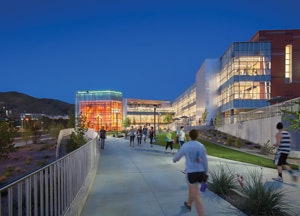 George S. Eccles Student Life Center, University of Utah
George S. Eccles Student Life Center, University of Utah
A Campus Asset
Today's campus recreation centers are hailed as a must for recruiting students, but that hasn't always been the case. "In early facilities, the emphasis was providing activity space for students to use," Kocher says. "They weren't judged as a driver of admissions or retention. The concept of quality came later."
Recognizing the greater value of these facilities, administrators — and students, through referenda and fees — were willing to invest more into them. "Schools are starting to appreciate the benefit of providing a sophisticated recreation and wellness experience to their students, so funding dollars are starting to fall in line with academic investments," Massey says.
"We have heard from the admissions office that this is the first place they bring groups of prospective students."— Samuel Hirth, on Vanderbilt University’s Student Recreation Center, a 1991 Facility of Merit |
As the role of recreation on the college campus has come to the forefront, design priorities have shifted accordingly. "The competition for attracting students, combined with the escalating cost of higher education, forces campuses to carefully consider priorities," Sgarzi says. "Facilities must be efficient, well-located, and highly utilized while being attractive and appealing. There is certainly a higher scrutiny on the perceived health club luxuries and more emphasis on the educational environment and teaching healthy living."
"It's not just the wow factor, it's the lifestyle, the idea of embracing wellness," agrees Braam. "We know that it's the students who are exercising who get better grades. At the end of the day, it's about the students and what they need and what can improve their quality of life."
Where do we go from here?Architects offer their campus rec predictions.
Jack Patton, RDG Planning & Design: "Integrated. Some part of that is focused on wellness, some part of that is focused on much broader clinical health, student health, biomechanics analysis. Student recreation in the future is going to integrate more opportunities and more campus- and place-specific, purposeful outcomes."
James Braam, HOK: "Innovation of what we see as hybrid workouts. What was just at one time jogging now is an evolution of jogging, running, sprinting and interval training in this high-performance area."
Erik Kocher, Hastings+Chivetta: "I don't think it'll be very long before you can do a workout wearing your virtual reality glasses and be immersed in the activity. Why do you have to play intramurals with your buddies? Why can't you play with Michael Jordan and Kareem and Magic Johnson?"
Bill Massey, Sasaki: "Technology will continue to create innovation in recreation. On the most basic scale, take Fitbit — the more people know about their bodies and the impact food, exercise, sleep and wellness have on their physical and psychological health, the more they will cater their routines accordingly."
Chris Sgarzi, Sasaki: "Wearables are everywhere, and although they might not have a direct impact on rec center design, they are indicative of the desire to monitor progress and improvement. The technology can help directors better understand program demands, equipment needs and scheduling."
Colleen McKenna, CannonDesign: "One area that I'm intrigued by is games like Ninja Warrior and Tough Mudder. They're often very complex endeavors, but will parts of these games migrate into campus recreation?"
Reed Voorhees, CannonDesign: "The technology is there now where the building can know who the student is just by what they're wearing, essentially, and I think eventually we'll be able to track their activity and they'll be able to utilize the tech to track their performance and workout and activities." |
This article originally appeared in the April 2017 issue of Athletic Business with the title "From weights to wellness: The evolution of campus recreation." Athletic Business is a free magazine for professionals in the athletic, fitness and recreation industry. Click here to subscribe.












